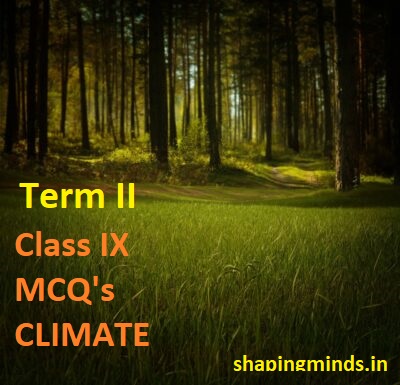Class IX – Term II Climate MCQ’s: 30 Most Challenging Geography Questions
Get selected 30 most difficult Term II Climate chapter MCQ’s here for practice and revision. Most of these questions for Term II from Climate you will not find on any website. Term I is over. Now start preparing for Term II. In Class IX Geography, Climate is the most difficult chapter. Therefore, here I have framed 30 questions from almost every important paragraph. If you solve these questions in sequence, your understanding of the chapter will be better. Though, term II will not only have MCQ’s, but it will also have subjective questions. Apart from solving these 30 Term II Climate MCQ’s, don’t miss Class IX Term II Climate Chapter 4 Question Answers For Revision. Here you will find how to write answers in Term II from Climate chapter.
Basic Questions For Term II From Climate
Q1. What refers to the sum total of weather conditions and variations over a large area for more than thirty years.
A. Weather
B. Climate
C. Monsoon
D. Atmospheric pressure.
Q2. The elements of weather and climate are
A. Same
B. Different
C. Not exactly the same
D. None of the above.
Q3. The word monsoon is derived from the Arabic word ‘mausim’ which literally means
A. Climate
B. Weather
C. Monsoon
D. Season.
Q4. In general, which areas experience less contrasts in temperature conditions?
A. Plains
B. Deserts
C. Coastal areas
D. Places located in the interiors of continent.
Q5. What will happen if the houses in Rajasthan (desert) do not have thick walls?
A. The houses will be extremely hot in the day.
B. The houses will be extremely cold at night.
C. Only A
D. Both A and B
Q6. Why the houses in Rajasthan have flat roofs?
A. Flat roofs help in Rainwater harvesting.
B. Flat roofs prevent the house from heat.
C. Gardening can be done on flat roofs.
D. Constructing flat roofs in Rajasthan is economical.
Average Difficulty Level Questions From Climate
Q7. Which place in India will have wide difference in day and night temperature?
A. Plains
B. Deserts
C. Coastal areas
D. Places which are located near the equator.
Q8. Which place in India receive less than 10 cm of rainfall?
A. Meghalaya
B. Tamil Nadu
C. Ladakh
D. Arunachal Pradesh
Q9. Places located near the equator are generally hot. Ooty is located close to equator as compared to Delhi but is cooler during summers why?
A. because Ooty is far from the sea.
B. because Ooty lies in the leeward side of mountains.
C. because Ooty is located on higher altitude.
D. because Ooty receives more rain than Delhi.
Q10. Western Cyclonic Disturbances in North and North-Western India are due to the winds coming from ____________
A. Mediterranean sea.
B. Madagascar islands.
C. South West Monsoons
D. North East Monsoons.
Q11. Monsoon winds bring enough rain during July to September but not during the rest of the year. Why?
A. During rest of the year monsoon winds blow from land to sea.
B. During rest of the year monsoon winds blow from sea to land.
C. This is due to the rotation of earth.
D. This is due to Coriolis force.
Application Based Questions from Climate
Q12. . The Coriolis-effect is responsible for deflecting winds towards the __________ in the northern hemisphere and towards the ____________ in the southern hemisphere.
A. Left, Right
B. Right, Left
C. Poles. Equator
D. Equator, Poles
Q13. If Himalayas are removed from India, what will be it’s effect on India’s climate? Identify the statement which is not correct.
A. India will be extremely cold during winter.
B. India will be extremely hot during summer.
C. Seasonal reversal of wind direction will not take place.
D. The intensity of rainfall will decrease.
Q14. In which particular season the Subtropical Westerly Jet streams do not blow over India?
A. Summer
B. Winter
C. Rainy
D. None of the above.
Q15. What happens to the Sub-tropical Westerly Jet streams in India during summer?
A. It blows over 27°-30° North latitude.
B. It moves towards Peninsular India.
C. It moves North of the Himalayas.
D. It blows over the equator.
Q16. Which factor affects the Indian Monsoon.
A. High pressure area to the North of Madagascar.
B. High pressure area to the South of Madagascar.
C. High pressure area to the East of Madagascar.
D. High pressure area to the West of Madagascar.
Q17. Where will the ITCZ shift when it is Christmas in India?
A. On the equator.
B. 20 degree North of equator.
C. 20 degree South of equator.
D. Over the Pacific ocean.
http://https://www.youtube.com/watch?v=Lc-75bi61KE
Q18. In which season the Australians celebrate Christmas.
A. Summer
B. Winter
C. Spring
D. Autumn
HOTS Questions From Class IX Climate
Q19. Who coined the word “Monsoon”?
A. Spanish
B. Arabs
C. Chinese
D. Indians
Q20. El-Nino is a warm ocean current that makes the Indian Monsoon ________________.
A. Delay
B. Weak
C. Does not affect monsoon.
D. Strong
Q21. Burst in Monsoon is
A. rainfall increases suddenly and continues constantly for several days.
B. arrival of monsoon.
C. retreating monsoon
D. rainfall equally distributed
Q22. The withdrawal of monsoon in India takes place from
A. East to West
B. West to East
C. North to South
D. South to North
Q23. These low-pressure systems, originate over the Mediterranean Sea and western Asia and move into India, along with the westerly flow locally known as “Mahawat” are important for the cultivation of which crops?
A. Kharif
B. Rabi
C. Both Kharif and Rabi
D. None of the above.
Q24. In which part of India there is hardly any noticeable change in temperature patterns during the winter season?
A. Eastern part
B. Western part
C. Northern part
D. Southern part.
Q25. Which place will be the warmest during summer nights in India?
A. Northern Plains
B. the Himalayas
C. Thar desert
D. Coastal plains
Q26. Loo is a striking feature of the hot weather season. It is common in which parts of India?
A. East and North Eastern parts of India.
B. West and North Western parts of India.
C. North and North Western parts of India
D. South and South Western parts of India.
Calculation-Based Questions From Class IX Climate
Q27. A place has a maximum temperature of 42.4 degrees and a minimum temperature of 24.7 degrees. What will be its diurnal range of temperature?
A. 33,55 Degree
B. 17.7 Degrees
C. 28.1 Degrees
D. 14.11 Degrees.
Q28. A place has a maximum temperature of 34.4 degrees and a minimum temperature of 25.6 degrees. What will be its mean temperature?
A. 30 Degrees
B 8.8 Degrees
C. 8.08 Degrees
D. 60 Degrees
Q29. Kerala is the first state to receive monsoon rains. Which state receives the last rain from monsoons.
A. Jammu & Kashmir
B. Arunachal Pradesh
C. Rajasthan
D. Tamil Nadu
Q30. Pre Monsoon showers which help in the early ripening of mangoes are common in which states?
A. Kerala and Tamil Nadu
B. Tamil Nadu and Karnataka
C. Karnataka and Kerala
D. Tamil Nadu and Maharashtra.
Conclusion: Term II Climate MCQs For Class IX
These selected 30 questions will help you in preparing for your Term II Climate chapter. But, do not just stick to MCQs because class IX Term II will also have subjective questions. You must know how to write short answers in points to score well in your Term II Geography. If you need help click on the given link to get all types of questions along with their answers Class IX Term II Climate Chapter 4 Question Answers For Revision. If you really liked the questions for term II from the Climate chapter, you may subscribe for further notification of the next chapter. Do ask and discuss these questions with your teachers and friends.
Could you answer more than 20 questions? Write your views and score below in the contact form.
All the best.





0 Comments